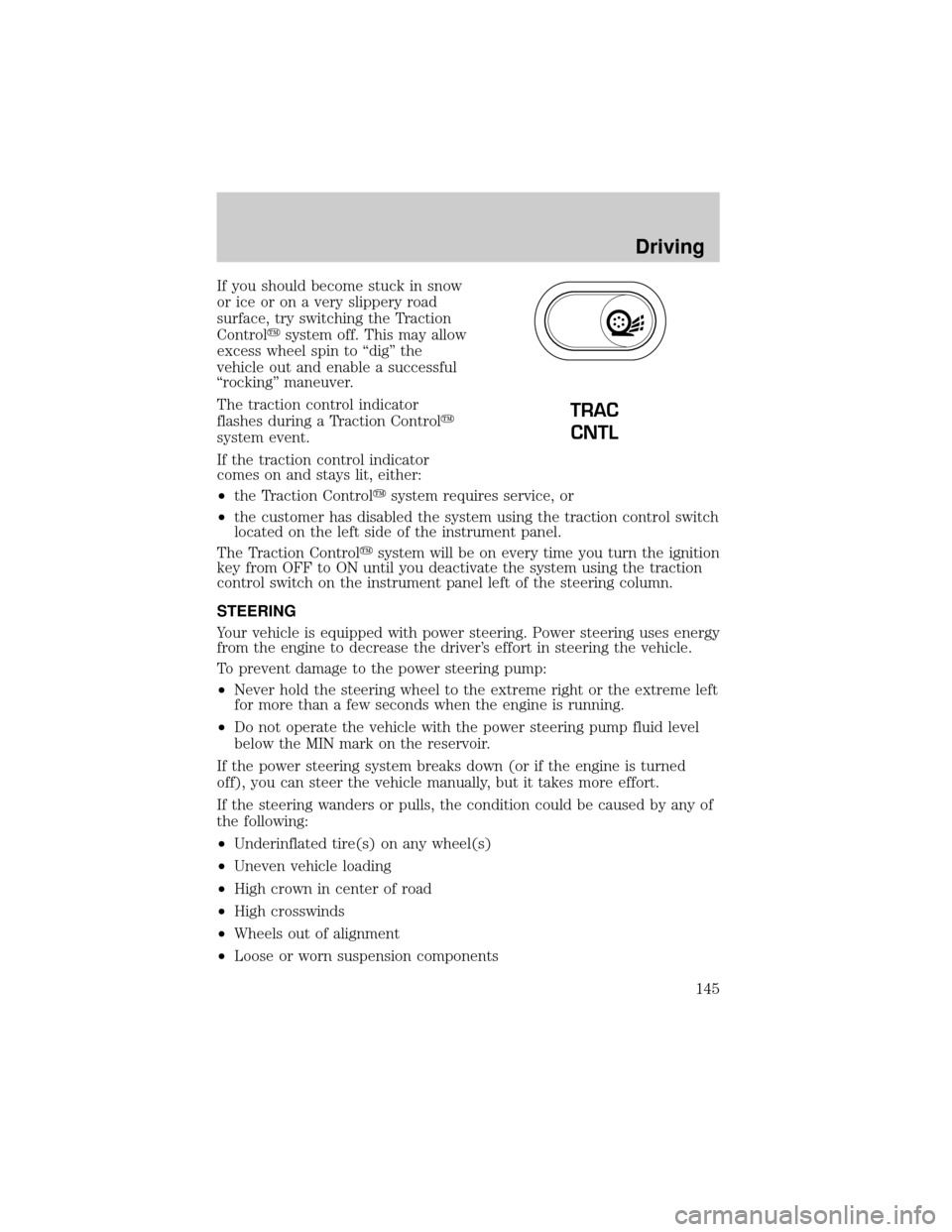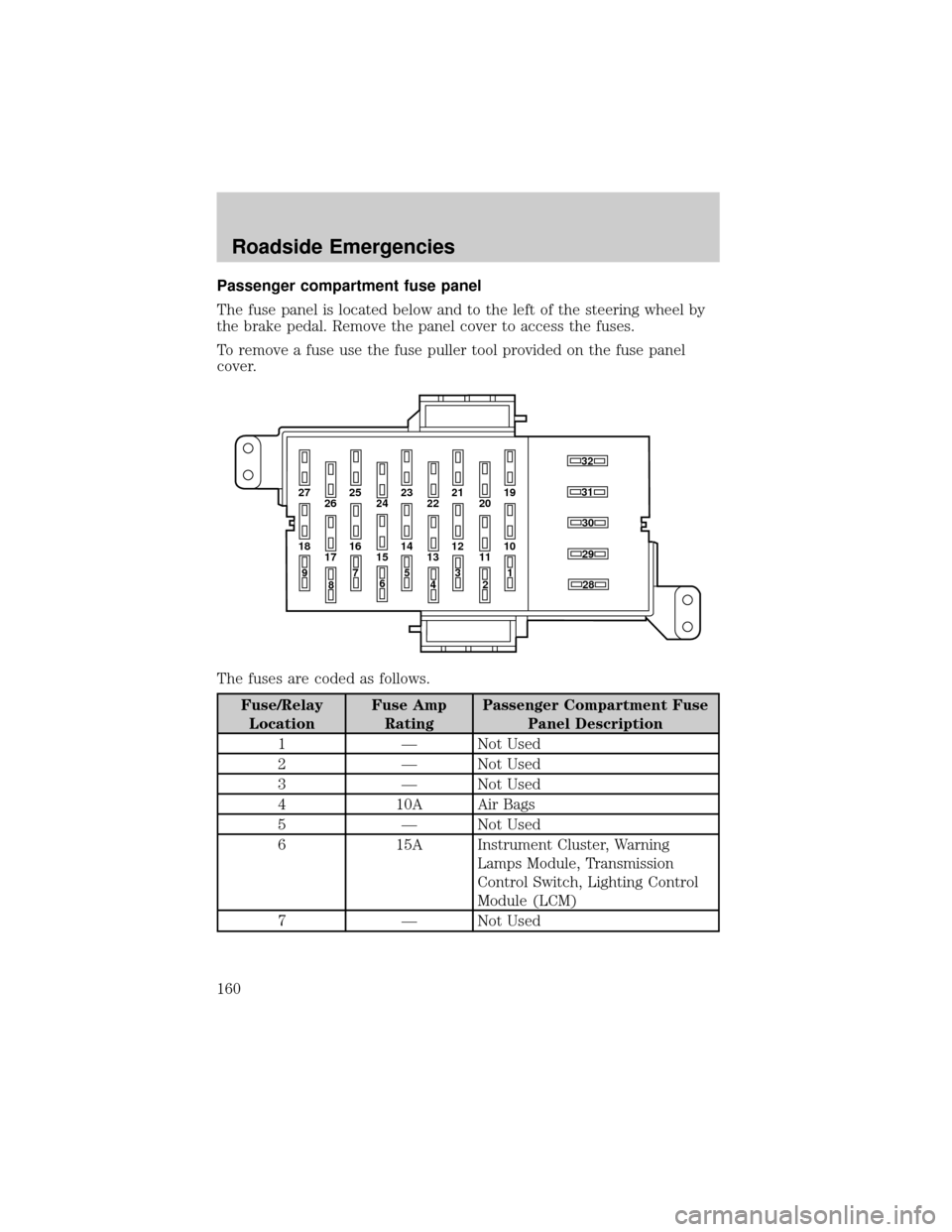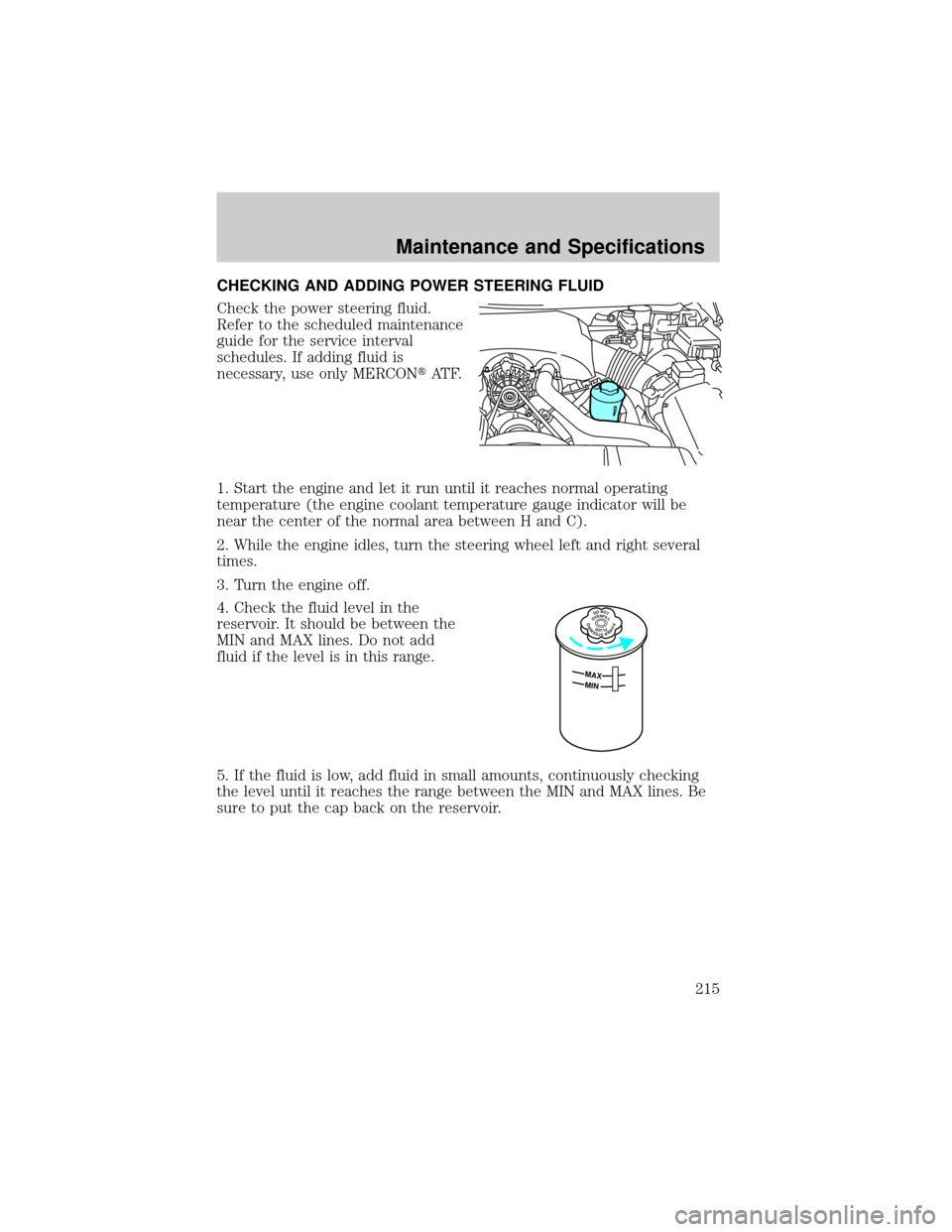2002 FORD CROWN VICTORIA steering wheel
[x] Cancel search: steering wheelPage 145 of 240

If you should become stuck in snow
or ice or on a very slippery road
surface, try switching the Traction
Controlysystem off. This may allow
excess wheel spin to ªdigº the
vehicle out and enable a successful
ªrockingº maneuver.
The traction control indicator
flashes during a Traction Controly
system event.
If the traction control indicator
comes on and stays lit, either:
²the Traction Controlysystem requires service, or
²the customer has disabled the system using the traction control switch
located on the left side of the instrument panel.
The Traction Controlysystem will be on every time you turn the ignition
key from OFF to ON until you deactivate the system using the traction
control switch on the instrument panel left of the steering column.
STEERING
Your vehicle is equipped with power steering. Power steering uses energy
from the engine to decrease the driver's effort in steering the vehicle.
To prevent damage to the power steering pump:
²Never hold the steering wheel to the extreme right or the extreme left
for more than a few seconds when the engine is running.
²Do not operate the vehicle with the power steering pump fluid level
below the MIN mark on the reservoir.
If the power steering system breaks down (or if the engine is turned
off), you can steer the vehicle manually, but it takes more effort.
If the steering wanders or pulls, the condition could be caused by any of
the following:
²Underinflated tire(s) on any wheel(s)
²Uneven vehicle loading
²High crown in center of road
²High crosswinds
²Wheels out of alignment
²Loose or worn suspension components
TRAC
CNTL
Driving
145
Page 160 of 240

Passenger compartment fuse panel
The fuse panel is located below and to the left of the steering wheel by
the brake pedal. Remove the panel cover to access the fuses.
To remove a fuse use the fuse puller tool provided on the fuse panel
cover.
The fuses are coded as follows.
Fuse/Relay
LocationFuse Amp
RatingPassenger Compartment Fuse
Panel Description
1 Ð Not Used
2 Ð Not Used
3 Ð Not Used
4 10A Air Bags
5 Ð Not Used
6 15A Instrument Cluster, Warning
Lamps Module, Transmission
Control Switch, Lighting Control
Module (LCM)
7 Ð Not Used
27 25
26 2423 21
2219
20
18 16
17 1514 12
131030
32
31
28
29
11
97
8653
41
2
Roadside Emergencies
160
Page 164 of 240

Fuse/Relay
LocationFuse Amp
RatingPower Distribution Box
Description
10 50A** See Fuses 1, 2, 6, 7, 10, 11, 13
and Circuit Breaker 14
11 50A** See Fuses 4, 8, 16 and Circuit
Breaker 12
12 30A** PCM Power Relay, PCM, Natural
Gas Vehicle Module
13 50A** High Speed Cooling Fan Relay
14 40A** Rear Window Defrost Relay, Also
see Fuse 17
15 40A** Anti-Lock Brake Module
16 50A** Police Option Fuse Holder
17 30A CB Cooling Fan Relay
Relay 1 Ð Rear Defrost Relay
Relay 2 Ð Horn Relay
Relay 3 Ð Cooling Fan Relay
Relay 4 Ð Air Suspension Pump Relay,
Police Power Relay
* Mini Fuses ** Maxi Fuses
Relays
Relays are located in the power distribution box and should be replaced
by qualified technicians.
CHANGING THE TIRES
If you get a flat tire while driving, do not apply the brake heavily.
Instead, gradually decrease your speed. Hold the steering wheel firmly
and slowly move to a safe place on the side of the road.
The use of tire sealants is not recommended and may compromise the
integrity of your tires. The use of tire sealants may also affect your tire
pressure monitoring system (if equipped).
Temporary spare tire information
Your vehicle may have a temporary or full-size spare tire. The temporary
spare tire for your vehicle is labeled as such. It is smaller than a regular
tire and is designed for emergency use only. Replace this tire with a
full-size tire as soon as possible.
Roadside Emergencies
164
Page 188 of 240

CLEANING THE INSTRUMENT PANEL
Clean the instrument panel with a damp cloth, then dry with a dry cloth.
Avoid cleaners or polish that increase the gloss of the upper portion of
the instrument panel. The dull finish in this area helps protect the driver
from undesirable windshield reflection.
Your vehicle is designed with painted controls and features which
are particularly sensitive to certain products such as insect
repellent and suntan lotion. When operating the various features
on your vehicle, be certain to wash or wipe your hands clean if
you have been in contact with any of these types of products in
order to avoid possible damage to the painted surfaces.
Do not use chemical solvents or strong detergents when cleaning
the steering wheel or instrument panel to avoid contamination of
the air bag system.
Cleaning the instrument cluster lens
Wipe the cluster area with a soft, damp cotton towel. Dry the area with a
clean, dry towel.
CLEANING SEATS EQUIPPED WITH SIDE AIR BAGS
Remove dust and loose dirt with a vacuum cleaner. In order to remove
stains and soil, clean with Extra Strength Upholstery Cleaner
(E8AZ-19523±AA).
Never saturate the seat covers with any cleaning solution.
Do not use chemical solvents or strong detergents when cleaning
the seat where the side air bag is mounted. Such products could
contaminate the side air bag system and affect performance of the side
air bag in a collision. The air bag may not function correctly and not
provide injury reduction benefits.
CLEANING THE INTERIOR FABRIC, CARPETS AND CLOTH SEATS
Remove dust and loose dirt with a vacuum cleaner. Remove light stains
and soil with Extra Strength Upholstery Cleaner (E8AZ-19523±AA).
Never saturate the seat covers with cleaning solution.
Do not use household cleaning products or glass cleaners, which
can stain and discolor the fabric and affect the flame retardant
abilities of the seat materials.
Cleaning
188
Page 215 of 240

CHECKING AND ADDING POWER STEERING FLUID
Check the power steering fluid.
Refer to the scheduled maintenance
guide for the service interval
schedules. If adding fluid is
necessary, use only MERCONtAT F.
1. Start the engine and let it run until it reaches normal operating
temperature (the engine coolant temperature gauge indicator will be
near the center of the normal area between H and C).
2. While the engine idles, turn the steering wheel left and right several
times.
3. Turn the engine off.
4. Check the fluid level in the
reservoir. It should be between the
MIN and MAX lines. Do not add
fluid if the level is in this range.
5. If the fluid is low, add fluid in small amounts, continuously checking
the level until it reaches the range between the MIN and MAX lines. Be
sure to put the cap back on the reservoir.
DONOTOVERFILLPOWERSTEERINGFLUID
MAX
MIN
Maintenance and Specifications
215
Page 234 of 240

child safety belts ....................127
Child safety seats ......................130
attaching with tether straps ..135
in front seat ............................132
in rear seat ......................132, 134
Cleaning your vehicle
engine compartment ..............186
exterior ....................................189
instrument cluster lens ..........188
instrument panel ....................188
interior .....................................188
plastic parts ............................187
safety belts ..............................189
washing ....................................184
waxing .....................................184
wheels ......................................185
windows ..................................189
wiper blades ............................187
Climate control (see Air
conditioning or Heating) ......54, 56
Clock ..........................25, 30, 36, 44
Compass, electronic ....................77
calibration .................................78
set zone adjustment .................77
Console ........................................90
Controls
power seat .......................106, 108
steering column ........................83
Coolant
checking and adding ..............199
coolant temperature light ........13
refill capacities ................203, 225
specifications ..................226, 228
Cruise control (see Speed
control) ........................................79
Customer Assistance ................156
Ford accessories for your
vehicle .....................................190Ford Extended Service
Plan ..........................................177
Getting assistance outside the
U.S. and Canada .....................181
Getting roadside assistance ...156
Getting the service you
need .........................................175
Ordering additional owner's
literature .................................182
The Dispute Settlement
Board .......................................178
Utilizing the
Mediation/Arbitration
Program ...................................180
D
Daytime running lamps
(see Lamps) ................................63
Defrost
rear window ..............................62
Dipstick
automatic transmission
fluid ..........................................216
engine oil .................................193
Doors
lubricant specifications ..........226
Driving under special
conditions
through water .........................150
E
Electronic message center .........83
Emergencies, roadside
jump-starting ..........................169
Emission control system ..........213
Engine ........................................228
check engine/service engine
soon light ..................................10
Index
234
Page 238 of 240

cleaning the safety
belts .................................122, 189
extension assembly ................121
for adults .........................113±115
for children .............................127
lap belt ....................................116
Occupant Classification
Sensor ......................................110
warning light and
chime ...................13, 16, 117±118
Safety seats for children ..........130
Seat belts (see Safety
restraints) ..................................108
Seats ..........................................104
child safety seats ....................130
cleaning ...................................188
SecuriLock passive anti-theft
system ................................100±102
Servicing your vehicle ..............191
Spare tire (see Changing the
Tire) ...........................................164
Spark plugs,
specifications .....................224, 228
Specification chart,
lubricants ...........................226, 228
Speed control ..............................79
Speedometer ...............................20
Starting your vehicle ........137±139
jump starting ..........................169
Steering
speed sensitive .......................146
Steering wheel
controls ..........................73, 79, 83
tilting .........................................73T
Tires ...........................164, 220±221
changing ..........................164±165
checking the pressure ............221
replacing ..................................223
rotating ....................................221
snow tires and chains ............224
tire grades ...............................221
treadwear ................................220
Towing .......................................152
recreational towing .................155
trailer towing ..........................152
wrecker ....................................174
Traction control ........................144
active light ................................14
Traction-lok rear axle ...............150
Transmission .............................146
fluid, checking and adding
(automatic) .............................216
fluid, refill capacities ..............225
lubricant specifications ..226, 228
Trip odometer .............................21
Trunk ...........................................92
remote release ....................89, 95
Turn signal ............................15, 65
V
Vehicle dimensions ...................228
Vehicle Identification Number
(VIN) ..........................................230
Vehicle loading ..........................151
Ventilating your vehicle ...........141
Index
238